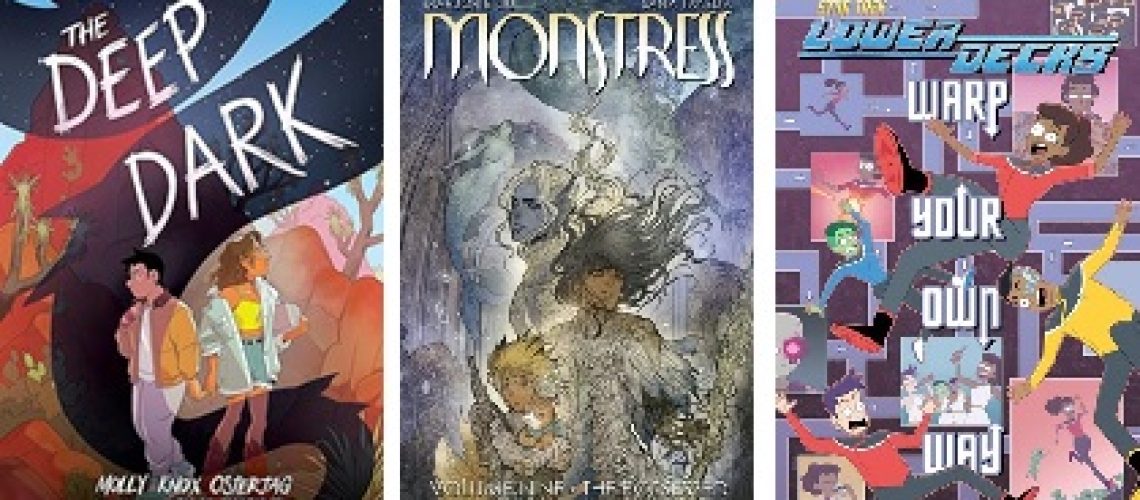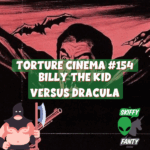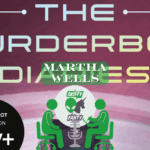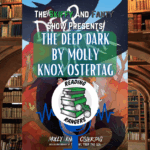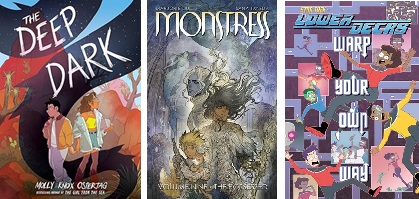
Way back when I started writing about comics for Skiffy & Fanty (in… what? 2017? Sounds fake. To be fair, there was a big, long, the-pandemic-ate-my-brain hiatus in the middle there where I wasn’t writing anything), a big part of my motivation was to help broaden the kind of comics and graphic novels that got recognition from SFFnal (mostly-) prose readers. I especially hoped to broaden the works that were considered for the Hugo Awards.
Well. Problem solved!
I didn’t have much to do with it — the readers and voters did it without needing my input — but I still got my preferred outcome, so I call that a win. If we use the finalists for the Best Graphic Story Hugo as a proxy for broader recognition, then SFFH readers over the past eight years have absolutely been casting a wide net and looking at a tremendous, a truly impressive and inspiring range of comics and graphic novels, holding them up as award-worthy works that need and deserve to be read. And that very much includes this year’s finalists.
To celebrate that, I’d like to take a closer look at the finalists for the 2025 Best Graphic Story Hugo Award. The last time I tried to review an entire award list, it ran a little long, so I’m going to start with three finalists, and look at the other three my next time out. I get two columns for the same amount of reading! That’s what we call efficiency around here!
This first set are the first three books I read, and are listed in alphabetical order, so they aren’t ranked in any other way. With that established, let’s dive in!

Molly Knox Ostertag
The Deep Dark: A Graphic Novel
By Molly Knox Ostertag
Published by Graphix, an imprint of Scholastic
Everyone has secrets. Mags’s has teeth.
Magdalena Herrera is about to graduate high school, but she already feels like an adult with serious responsibilities: caring for her ailing grandmother; working a part-time job; clandestine makeouts with a girl who has a boyfriend. And then there’s her secret, which pulls her into the basement each night, drains her of energy, and leaves her bleeding. A secret that could hurt and even kill if it ever got out—like it did once before.
So Mags keeps her head down, isolated in her small desert community. That is, until her childhood friend Nessa comes back to town, bringing vivid memories of the past, an intoxicating glimpse of the future, and a secret of her own. Mags won’t get attached, of course. She’s always been strong enough to survive without anyone’s help.
But when the darkness starts to close in on them both, Mags will have to drag her secret into the daylight, and choose between risking everything… or having nothing left to lose.
As our podcast listeners may already know, I really admire The Deep Dark, and I have a lot to say about it. I encourage you to listen to Shaun’s and my conversation in our recent Reading Rangers episode, because Shaun is smart and erudite about this fine book, and I’m certainly enthusiastic about it.
Our podcast discussion, like my reviews, contains spoilers, so Shaun and I kind of skipped over one thing that Ostertag does in The Deep Dark that I really appreciated, to get to the story’s first big reveal and the central conflict (and metaphor) in the narrative that it unlocks. I’d like to unpack that here.
In introducing the characters, the conflicts, and in building tension, Ostertag is incredibly cagey about The Deep Dark‘s fantastical elements, right up until that first big reveal blows it all wide open. If you read that summary above again (it’s the back cover copy), and went into The Deep Dark without knowing much else about it, Ostertag would absolutely trick you into thinking you were reading a fairly conventional vampire story. I know, because I totally fell for it. I mean, Ostertag is a justly acclaimed creator and the graphic novel is a Hugo finalist, so I was confident it wasn’t going to be entirely conventional, but I still got well and truly faked out by the red herrings until the unfolding reveals of what was actually going on, which is far more interesting, deep, powerfully metaphorical, and nuanced.
And that nuance is reflected across the entire meticulous, thoughtful edifice of The Deep Dark. Shaun and I talked a lot about the book’s use of both colour and black and white art, which is strikingly effective. We also touched on the subtle characterization of some of both the main and supporting cast. The narrative misdirection is all of a piece with that nuance. And it all goes to what I believe is a major theme of the work: That keeping the truth locked away, in the dark, obscures not just the secrets that we’re trying to hide, but everything around them. It locks us away from understanding ourselves and one another.
This is a truly outstanding graphic novel and a very worthy nominee. I recommend it unreservedly.
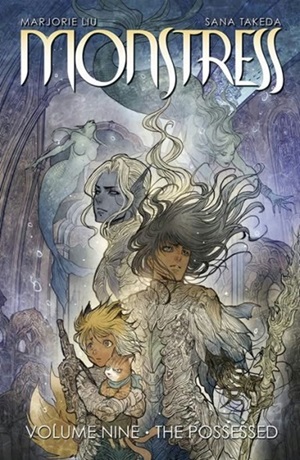
Monstress Volume Nine: The Possessed
Writer – Marjorie Liu
Artist – Sana Takeda
Rus Wooton – Lettering & Design
Editor – Jennifer M. Smith
Production Assistant – Erika Schnatz
Editorial Assistant – Ceri Riley
Letting Assists – Jackie Marzan
Published by Image Comics
Can loyalty and love transcend a history of betrayal and blood?
Maika, Kippa, and Ren return to their own world to discover a full year has passed in their absence—and Zinn is back in the clutches of Maika’s father, the megalomaniacal Lord Doctor. From the relative safety of the pirate-controlled Spice Islands, Maika and her friends must regroup, recover, and find a way to stop the Lord Doctor’s murderous rampage before he destroys the Known World.
Okay, I need to admit something: I have no idea what’s going on in Monstress anymore. I thought I’d read everything leading up to this volume, but I wasn’t going to re-read eight books just to be ready for this one, so I didn’t and then the story opens with Maika Halfwolf, the feline duellist, poet, and spy Master Ren, and their mutual resident morality pet, Kippa the fox child, recovering from a trip to another world that I don’t remember at all. Also Maika at some point lost the ravenous Elder God she was using for an arm to… her father? Who I also don’t remember at all?
I’m pretty sure I accidentally skipped Volume Eight.
That’s a me problem, but it illustrates the challenge of evaluating this book — whether that’s for the Hugos or just as a reader — entirely on its own merits. Every volume of Monstress is dense in the best way — packed with character details, lore, relationships, rich visuals. But that density can be unforgiving for new readers (or, yes, ones who accidentally skipped Volume Eight).
It’s impossible to view what’s obviously a middle installment of an ongoing story entirely on its own, but here I’m going to try to respond to Monstress Volume Nine: Possessed as a discrete unit of story. As such, it’s very much a slow burn, and a slow drumbeat. There’s progression in Marjorie Liu’s story, a sense that things are about to get even worse, but not a conclusion as such. Kippa’s showing more signs of her own growing powers, and there are hints that she’s going to be a vital component to what comes next beyond her importance to Maika, Ren, and the once-again-imprisoned Elder God Zinn. Through Kippa’s abilities, we also learn more about Maika’s childhood and her mother’s schemes. There’s a child clone of Maika’s beloved frenemy, and an old friend who pretty clearly is or was in love with her (it really is a bit weird that so many people are in love with Maika given how she’s always portrayed as the absolute worst, what with all the war crimes.)
Sana Takeda’s art remains breathtaking; somehow painterly without being static, richly depicting a world that feels real and textured.
So yes, it’s still very good. I understand why it’s a Hugo finalist. But my appreciation has to contain a caveat. If you already love Monstress, you’ll love Volume Nine too. It keeps the plot moving forward, it unveils more secrets. Things are definitely moving towards a crescendo. If you haven’t been reading Monstress, and didn’t read the eight preceding volumes to get caught up? This probably won’t land for you.
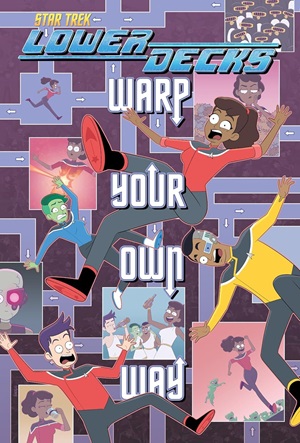
Star Trek: Lower Decks: Warp Your Own Way
Written by Ryan North
Art by Chris Fenoglio
Colors by Charlie Kirchoff
Letters by Jeff Eckleberry
Published by IDW Publishing
Warp into the action with Star Trek’s first-ever interactive original graphic novel!
Mariner just wants to have a normal day, but no matter what side of the bed she wakes up on, the world is ending. Literally. If she has coffee, Borg attack! If she has raktajino, cue the Romulan boarding party! And in each scenario, Mariner and her friends end up dead, sometimes the ship is destroyed—and the day starts all over again.
But by exploring the different paths, you, the reader, can discover things that Mariner can’t. There are inconsistencies that don’t make sense—putting aside the fact that Mariner’s choice of drink each morning shouldn’t affect which alien races attack the ship, other facts of her world seem to change too. Something is definitely off. It’s up to you to discover!
I’m amused by that description, “interactive graphic novel”. Mostly because it reminds me of the old story in the comics business (probably not true) that Will Eisner coined the term “graphic novel” because he didn’t want the publisher he was pitching to know in advance that he was trying to sell them a big comic book. It wasn’t a lie. It was the truth, but a better-sounding version of the truth, a truth designed to get Eisner’s foot in the door.
“Interactive graphic novel”, while it’s not an untrue description of Warp Your Own Way, is similarly deliberately classed-up. What this is, is a gamebook. Specifically, one that’s clearly inspired by the classic Choose-Your-Own-Adventure books, and their structure and format (although it’s not part of that venerable, trademarked series).
I’m not sure if “graphic gamebook” is or should be a thing, but I’m going to use the term (suggested by the illustrious Trish!) for the purpose of this review. And I’m going to use to to emphasize that this graphic gamebook is not only a really good example of a gamebook, it’s also one that’s meta on several levels about being a gamebook, while still being a note-perfect Star Trek: Lower Decks story.
This turned out to be one of those graphic novels that I like more and more, the more I think about it. My initial impression was that it was fun, and clever, maybe a bit too clever. I also thought that its appeal really leaned on how much everyone already loves Lower Decks, and that it was a bit too Mariner-centric. (Sorry, Mariner stans. I’m a Boimler guy.)
But after some reflection? I just keep getting more and more impressed with what the creators accomplished here. That basic outline of the plot is accurate — the reader chooses what Mariner will do next, and learns what’s happening as she does. But vitally, that’s true not just when Mariner succeeds, but when she doesn’t, via bad outcomes that lead to her getting phasered to death or the Cerritos blowing up, and the reader going back and trying again. It becomes clear over one terrible iteration of Mariner’s day after another that this isn’t merely a device that’s external to the narrative. Someone is deliberately and repeatedly putting Mariner — or Mariners —into these fatal variations on a theme, trying to learn something. Who, why, and how to stop them thus become the questions, in the best Star Trek mindscrew episode fashion.
Then the fourth wall breaks hard, and the mindscrew becomes even mindscrew-ier.
Ryan North captures Mariner’s voice and the tone of Star Trek: Lower Decks perfectly, and Chris Fenoglio’s art matches the show’s look and feel equally well. But fascinatingly, Warp Your Own Way also both perfectly reflects the writing and feel of reading a classic, old-school Choose-Your-Own-Adventure book from my childhood. And it perfectly reflects how readers actually experienced a Choose-Your-Own-Adventure, and how we got through them — by remembering bad outcomes, going back, and avoiding them, and sometimes by cheating a bit. Just like the reader does here. Just like Mariner does here.
Drawing on two completely different sources, with different narrative structures, bringing them together seamlessly, and effectively deconstructing them and commenting on them both metatextually and explicitly within the narrative? That’s an achievement.
This is good Star Trek: Lower Decks, good interactive fiction, and good science fiction. I recommend it. But have a notepad handy, because if you’re anything like me, you’ll need to scribble yourself a little flowchart to remember all Mariner’s choices.
Not really a conclusion
As usual, I don’t have a final recommendation for Hugo voters, or a prognostication here — although it’s probably clear where my own preferences so far lie. There’s a lot to admire about all three of these graphic novels; they’re all strong works of SF&F in very different ways, and they’re all worth your time and attention.
Next time, I’ll look at the other three finalists on the Best Graphic Story Hugo ballot: The Hunger and the Dusk, Volume 1 by G. Willow Wilson and Chris Wildgoose; My Favorite Thing Is Monsters, Book 2 by Emil Ferris; and We Called Them Giants by Kieron Gillen, Stephanie Hans, and Clayton Cowles.
Disclosures: I have no personal or professional relationships with the creators. I obtained the graphic novels for review via my public library.

